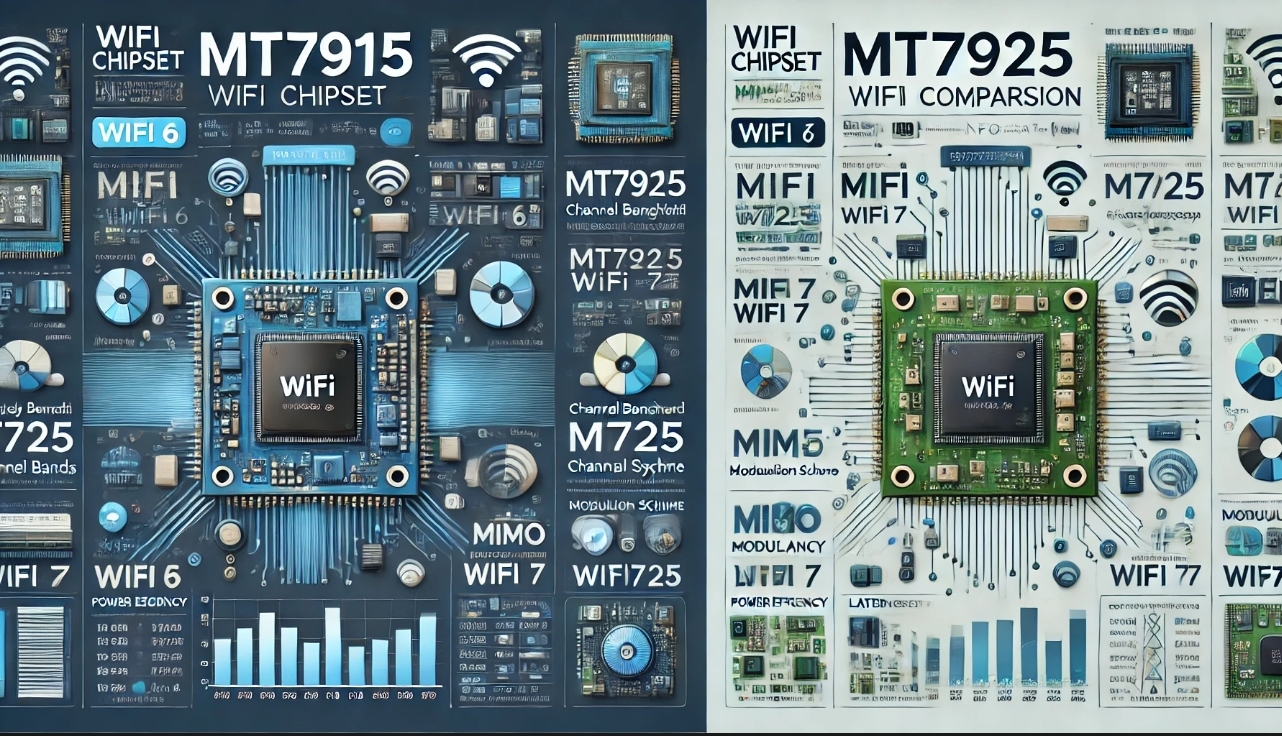MT7915 vs MT7925: Comprehensive Analysis of WiFi 6 and WiFi 7 Chipsets

MediaTek has been a significant player in the wireless communication industry, offering innovative and cost-effective solutions. Among their lineup, the MT7915 and MT7925 chipsets stand out as representatives of WiFi 6 and WiFi 7, respectively. This article provides a detailed technical comparison of these two chipsets, examining their features, applications, and performance metrics to help developers and system integrators make informed decisions.
Overview of WiFi 6 (MT7915) and WiFi 7 (MT7925)
WiFi 6: MT7915
MT7915 is a high-performance WiFi 6 chipset designed to meet the growing demand for faster speeds, increased capacity, and enhanced efficiency in dense environments. Its key features include:
Frequency Bands: Supports dual-band (2.4 GHz and 5 GHz).
Channel Bandwidth: Up to 160 MHz.
MIMO Configuration: 4x4 MU-MIMO.
Modulation Scheme: 1024-QAM, improving spectral efficiency.
OFDMA: Enables multiple devices to share channels efficiently.
Target Wake Time (TWT): Reduces power consumption for IoT devices.
Beamforming: Enhances signal strength and range.
Applications: MT7915 is ideal for home routers, enterprise access points, and IoT devices requiring reliable and efficient wireless connectivity.
WiFi 7: MT7925
MT7925 represents the next generation of wireless technology with WiFi 7 capabilities. It builds upon WiFi 6 with groundbreaking improvements:
Frequency Bands: Tri-band support (2.4 GHz, 5 GHz, and 6 GHz).
Channel Bandwidth: Up to 320 MHz, doubling WiFi 6’s bandwidth.
MIMO Configuration: 8x8 MU-MIMO.
Modulation Scheme: 4096-QAM, further enhancing spectral efficiency.
Multi-Link Operation (MLO): Combines multiple frequency bands for improved throughput and redundancy.
Enhanced OFDMA: Improves performance in high-density environments.
Reduced Latency: Achieves sub-millisecond latency, ideal for AR/VR and gaming applications.
Applications: MT7925 targets high-performance use cases like 8K streaming, cloud gaming, industrial IoT, and smart cities.
Technical Comparison
Performance Metrics
Speed and Throughput
The MT7925’s support for 320 MHz channel bandwidth and 4096-QAM results in significantly higher theoretical speeds compared to the MT7915. This makes the MT7925 suitable for applications requiring massive data transfers, such as 8K video streaming.
Latency
The sub-millisecond latency achieved by the MT7925 is a critical upgrade over the MT7915. This improvement caters to time-sensitive applications, including AR/VR and real-time gaming.
Power Efficiency
While both chipsets support TWT for power-saving, the MT7925 incorporates advanced mechanisms to optimize power consumption further, making it more suitable for battery-powered devices.
Deployment Scenarios
MT7915
Use Cases:
Residential WiFi networks
Small to medium-sized enterprise setups
IoT device connectivity
Advantages:
Cost-effective solution for moderate performance requirements.
Broad compatibility with existing WiFi 6 infrastructure.
MT7925
Use Cases:
Ultra-high-definition streaming and cloud gaming
Industrial automation and IoT networks
Smart cities and large-scale public WiFi deployments
Advantages:
Future-proof technology supporting WiFi 7.
Exceptional performance in dense and high-demand environments.
Conclusion
The MT7915 and MT7925 chipsets represent two different eras of wireless connectivity, each tailored to specific performance and application needs. The MT7915 excels as a reliable and efficient WiFi 6 solution, while the MT7925 pushes the boundaries of wireless technology with WiFi 7’s advanced features. Choosing the right chipset depends on the performance requirements, application scenarios, and budget considerations of the deployment.
By understanding the capabilities and limitations of each chipset, developers and integrators can ensure optimal wireless performance for their projects.










评论